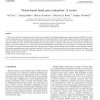Free Online Productivity Tools
i2Speak
i2Symbol
i2OCR
iTex2Img
iWeb2Print
iWeb2Shot
i2Type
iPdf2Split
iPdf2Merge
i2Bopomofo
i2Arabic
i2Style
i2Image
i2PDF
iLatex2Rtf
Sci2ools
121
click to vote
CVIU
2007
2007
Vision-based hand pose estimation: A review
Direct use of the hand as an input device is an attractive method for providing natural human–computer interaction (HCI). Currently, the only technology that satisfies the advanced requirements of hand-based input for HCI is glove-based sensing. This technology, however, has several drawbacks including that it hinders the ease and naturalness with which the user can interact with the computer-controlled environment, and it requires long calibration and setup procedures. Computer vision (CV) has the potential to provide more natural, non-contact solutions. As a result, there have been considerable research efforts to use the hand as an input device for HCI. cular, two types of research directions have emerged. One is based on gesture classification and aims to extract high-level abstract information corresponding to motion patterns or postures of the hand. The second is based on pose estimation systems and aims to capture the real 3D motion of the hand. This paper presents a liter...
| Added | 13 Dec 2010 |
| Updated | 13 Dec 2010 |
| Type | Journal |
| Year | 2007 |
| Where | CVIU |
| Authors | Ali Erol, George Bebis, Mircea Nicolescu, Richard D. Boyle, Xander Twombly |
Comments (0)

